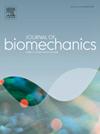A novel approach to assess coordination in people with transtibial amputations using continuous and event relative phase
IF 2.4
3区 医学
Q3 BIOPHYSICS
引用次数: 0
Abstract
Continuous relative phase (CRP) quantifies coordination for cyclic motions as the difference in the phase portrait locations between its constituent coordinates and has been widely used in populations with neuromuscular impairments. Continuous analyses, like statistical parameter mapping (SPM), provide greater resolution than traditional techniques that first compress CRP across a section of the cycle to a single point, like mean average relative phase (MARP). However, both analyses neglect the effect of intermediate event timing (e.g. toe-off), on coordination. Given this deficit and the notion that some people with transtibial amputations (PwTA) may not benefit from powered prostheses due to altered coordination, we computed lower extremity CRPs from 5 PwTA walking with their own passive prostheses and a powered device on a treadmill, as well as 5 matched able-bodied individuals (ABI). We then compared results from non-parametric SPMs to those from MARP using a 10-40-10-40 gait phase decomposition and extracted relative phase at the events that theoretically delineate the decomposition. We found continuous, discrete analyses matched well, particularly near ankle “push-off” (∼55 % gait cycle) with all methods identifying differences in shank-foot coordination between the ABI group and PwTA group walking with the powered device. Although it is unclear why the powered prosthesis promotes more in-phase shank-foot CRP, potential covariates include limb posture and device control. In tandem with altered event timing, these factors may not only influence coordination, but also illuminate why some PwTA do not reduce their energy expenditure when walking in powered ankle prostheses.
求助全文
约1分钟内获得全文
求助全文
来源期刊

Journal of biomechanics
生物-工程:生物医学
CiteScore
5.10
自引率
4.20%
发文量
345
审稿时长
1 months
期刊介绍:
The Journal of Biomechanics publishes reports of original and substantial findings using the principles of mechanics to explore biological problems. Analytical, as well as experimental papers may be submitted, and the journal accepts original articles, surveys and perspective articles (usually by Editorial invitation only), book reviews and letters to the Editor. The criteria for acceptance of manuscripts include excellence, novelty, significance, clarity, conciseness and interest to the readership.
Papers published in the journal may cover a wide range of topics in biomechanics, including, but not limited to:
-Fundamental Topics - Biomechanics of the musculoskeletal, cardiovascular, and respiratory systems, mechanics of hard and soft tissues, biofluid mechanics, mechanics of prostheses and implant-tissue interfaces, mechanics of cells.
-Cardiovascular and Respiratory Biomechanics - Mechanics of blood-flow, air-flow, mechanics of the soft tissues, flow-tissue or flow-prosthesis interactions.
-Cell Biomechanics - Biomechanic analyses of cells, membranes and sub-cellular structures; the relationship of the mechanical environment to cell and tissue response.
-Dental Biomechanics - Design and analysis of dental tissues and prostheses, mechanics of chewing.
-Functional Tissue Engineering - The role of biomechanical factors in engineered tissue replacements and regenerative medicine.
-Injury Biomechanics - Mechanics of impact and trauma, dynamics of man-machine interaction.
-Molecular Biomechanics - Mechanical analyses of biomolecules.
-Orthopedic Biomechanics - Mechanics of fracture and fracture fixation, mechanics of implants and implant fixation, mechanics of bones and joints, wear of natural and artificial joints.
-Rehabilitation Biomechanics - Analyses of gait, mechanics of prosthetics and orthotics.
-Sports Biomechanics - Mechanical analyses of sports performance.
 求助内容:
求助内容: 应助结果提醒方式:
应助结果提醒方式:


